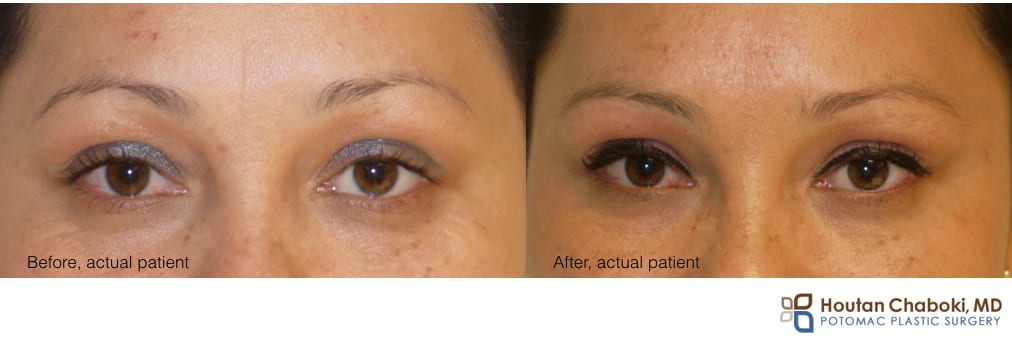We often hear from our Washington DC patients that not only do they want aesthetic treatments to improve current wrinkles, but they also want to help prevent future wrinkles down the road. Everyone wants to look their best, but they also want to look their best in the the future too. Preventative skin care can help achieve this goal.
Anecdotal evidence over the years in plastic surgery and dermatology offices suggests that patients who regularly receive a wrinkle relaxer (ie. Botox®, Dysport®, Xeomin®) have overall improved skin smoothness beyond the short-term wrinkle reduction that these treatments provide. It’s believed by some that consistent office procedures with these wrinkle relaxers may lead to a sustained improvement in appearance. Is there medical research to support this anti-aging effect and the prevention of long-term wrinkles? Should one start Botox when young to look their best when older?
Reason Botox might help prevent future wrinkles
Botox and similar treatments relax the facial muscles that contribute to wrinkles. Wrinkles and facial aging develop only partly from repeated folding of the skin from muscle contraction. The repeated contraction of facial muscles over years eventually results in frown lines, horizontal forehead lines, and crow’s feet. The pattern of lines in younger patients, obvious during certain facial expressions, predicts the unique pattern of facial wrinkling that occurs in older age.
If the action of the muscles of facial expression is diminished with wrinkle relaxers, the etched lines on the face may not form later in life. Regular treatment with a wrinkle relaxer, also known as a neuromodulator, when wrinkles aren’t present at rest (i.e. age 20’s or 30’s) may have a potential effect on the appearance of the face much later in life. Theoretically, there should be fewer, if any, wrinkles present if the repeated skin folding is prevented. Collagen remodeling might be occurring on the dermal and epidermal level, although no one knows for certain.
Supporting research on preventive Botox for anti-aging
A Beverly Hills plastic surgery practice presented a case report article on twin sisters who received Botox to help demonstrate this possible prevention effect (Rivkin A, Binder WJ. Dermatol Surg. 2015). The same physicians reported on these same twin sisters earlier in 2006 (Binder WJ. Arch Facial Plast Surg. 2006).
One sister received Botox regularly (every few months) in the forehead and glabella (ie. in between the eyebrows) beginning at age 25, and the other twin sister received Botox in these same areas a total of only four times over the entire 19 year reporting period. The article states that the twins had no other cosmetic treatment other than these Botox injections over the 19 year period.
Several months after the last Botox treatment, facial wrinkles in the minimally treated twin were still visible at rest, however these wrinkles were not present in the regularly treated twin. The observation in this research article suggests that regular treatment with a neuromodulator (i.e. wrinkle relaxer), beginning before the wrinkles are etched into the skin (ie. young adult), can help prevent the development of etched-in lines when older.
Obviously, this research study is limited in many ways and further studies are still required to help answer this question, but it does support the preventative wrinkle relaxer theory.
Plastic surgeons will regularly recommend Botox every three months, as this is the normal time period for the Botox effect to last. Separate research by other dermatology and plastic surgery groups has suggested that the length of duration of the wrinkle reduction effect tends to last longer for patients who receive Botox regularly. Instead of three months, some patients come every four months or longer between treatments. We’ve seen this effect on duration, whether receiving Botox for jaw reduction or forehead wrinkles. As always, results will vary and plastic surgeons can never guarantee any outcomes.
When is too young to start Botox?
Plastic surgeons typically start Botox treatments for patients in their 20’s, but usually not younger. These younger patients may not necessarily be getting wrinkle relaxers to treat wrinkles per se, but rather use Botox to relax or lift the eyebrow. The glabella (in between eyebrows) and forehead are the most common areas treated.
For the best long-term preventive wrinkle reduction and healthy skin, basic skin care is far more important than any Botox or cosmetic treatments available. Skin hydration, avoiding smoking, topical retinoids, and sun protection have all been shown to improve one’s appearance. Botox, or other aesthetic procedures, are not as fruitful without these basics. Don’t plan on long-term wrinkle relaxers without the basics already in place.
If there is research (even limited research) that supports early use of Botox to help the skin look its best when one is older, then when is it too young to start? Plastic surgeons advocate early use of basic skin health treatments routinely. Should we also be advocating wrinkle relaxers for anti-aging?
What do you think? Have you considered preventative Botox? Please share your thoughts below.


One of the benefits of BOTOX injections is that they can be used to relax the facial muscles, resulting in smoother skin and fewer wrinkles. I think this is one of the most used and beneficial treatment.
We agree. Thank you reading our blog!